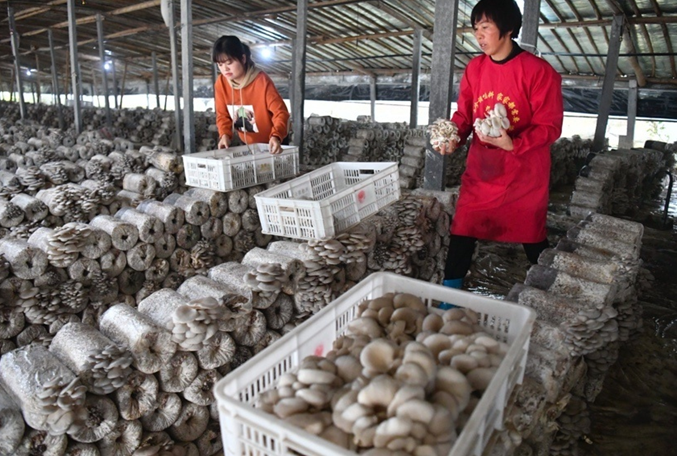


Photo taken on October 13 shows farmers pick up mushrooms in a greenhouse of a family farm in Bozhou, east China’s Anhui province. (Photo by Liu Qinli/People’s Daily Online)
“Thanks to the policy of the government, I feel more secure about getting rid of poverty,” said Fu Huaiqin, a resident in Heshunhui village, Weixian county, north China’s Hebei province.
The man was diagnosed with a bladder tumor last year. Although medical insurance was able to cover a part of his expenses, he still needed to pay a high cost of over 10,000 yuan (about $1,491) himself. His family, which had just shaken off poverty, was faced with the risk of getting into debt.
Fu’s predicament triggered a warning of the big data system of Weixian county preventing the reoccurrence of poverty.
Staff members with the local healthcare department verified his situation, provided a relief worth of 7,000 yuan for him, and advanced a series of measures concerning healthcare and employment, preventing Fu’s family from falling into poverty again.
Preventing the reoccurrence of poverty is an important part of China’s poverty alleviation. Preliminary statistics suggest that nearly 2 million people who have been lifted out of poverty are at risk of returning to poverty, and nearly 3 million of the population living barely above the poverty line could possibly be impoverished.
Local governments in China have actively explored and put into place a mechanism to effectively prevent people from falling back to poverty, and rolled out targeted measures to consolidate the results of poverty alleviation and ensure that the poverty alleviation goals will be achieved with high quality.
Both poverty-stricken households and those barely living above the poverty line are the main focus of attention in poverty reduction. Therefore, to prevent the reoccurrence of poverty calls for extra efforts for these groups.
The State Council Leading Group Office of Poverty Alleviation and Development has specified that family is the basic unit of the mechanism to prevent reoccurrence of poverty.
The mechanism monitors registered poverty-stricken households that have shaken off poverty and yet are still faced with risks of returning to poverty, as well as marginal households with an income slightly higher than that of registered poverty-stricken households.
East China’s Anhui Province has identified 61,279 marginal households and formulated 206,600 measures to provide assistance. Through well-targeted support, the province has already eliminated the risk of falling into poverty again for 18,029 of them.

Workers make uppers at a poverty alleviation workshop in Nujiang Lisu autonomous prefecture, southwest China’s Yunnan province, October 14. (Photo by Liang Zhiqiang/People’s Daily Online)
By collecting data on the targets through the monitoring mechanism and receiving warning of possible risks, China is trying to help those in need as soon as possible so that they won’t return to poverty.
The poverty alleviation data platform of northwest China’s Xinjiang Uygur autonomous region has collected the dynamic information about more than 160,000 poverty-stricken residents, over 2.92 million people who have been lifted out of poverty and 370,000 marginal population facing risks of falling into poverty. Their income levels are shown in four colors, red, orange, yellow and green, which indicate their corresponding risks of slipping back into poverty.
Weixian county, Guantao county and other areas in Hebei province have established a unified network concerning medical insurance, civil affairs, and emergency management, allowing the local government to accurately identify residents that have spent a large amount of money because of diseases or disasters and thus provide timely capital assistance.
To prevent residents from falling into or returning to poverty, it is crucial to improve the self-development capacity of the poor people, help them secure jobs and ensure sustained and stable income growth for them.
“I now earn over 2,000 yuan per month, plus a subsidy of 300 yuan. The job is easy and the income is basically the same as those villagers working out-of-town,” said Wang Zhaoxia, a resident in Tai’an village, Lu’an, Anhui province.
She once tried to secure a job in the cities, but failed as she lacked professional skills. Last year, she participated in training sessions provided by the village and found a job in a poverty alleviation workshop near her home.
She now processes wire harness for washing machines and becomes more confident about her future.
By adopting various measures such as vocational training, poverty alleviation collaboration and workshops, Anhui province has helped over 1.6 million poor residents secure a job and prevented them from returning to poverty.

Farmers, led by local officials, fertilize the soil at a strawberry planting base in Yuping Dong autonomous county, Tongren, southwest China’s Guizhou province, October 14. (Photo by Hu Panxue/People’s Daily Online)
China has also woven a strong security net to prevent residents from falling into poverty due to illness, disasters or education.
Provinces in the country have taken a series of measures to ensure that those who are incapable of working are provided with aid and guarantees and that families which fall into or return to poverty because of illnesses, disability, disasters and other accidents could receive timely assistance.
By developing industries, China has ensured long-term and effective results in poverty alleviation.
The country has implemented more than 980,000 industrial projects in poverty-stricken areas, covering 92 percent of the households in poverty.
As of the end of August, the national poverty alleviation projects, leading enterprises in poverty alleviation and workshops for poverty reduction had fully resumed work.
The number of rural migrant workers from poor areas reached 106 percent of that last year, and the country has consumed nearly 130 billion yuan on products and services from poor areas.
The tasks in the agreement on east-west pairing-off cooperation for poverty alleviation were over-fulfilled ahead of schedule.
China has so far sent 255,000 work teams, and sent more than 2.9 million officials from government departments at or above the county level and from state-owned enterprises and government-affiliated institutions to serve as first secretaries of Party village committees and village-stationed officials in poverty-stricken and backward villages. They are joining hands with poor residents in a bid to comprehensively win the fight against poverty.

 Award-winning photos show poverty reduction achievements in NE China's Jilin province
Award-winning photos show poverty reduction achievements in NE China's Jilin province People dance to greet advent of New Year in Ameiqituo Town, Guizhou
People dance to greet advent of New Year in Ameiqituo Town, Guizhou Fire brigade in Shanghai holds group wedding
Fire brigade in Shanghai holds group wedding Tourists enjoy ice sculptures in Datan Town, north China
Tourists enjoy ice sculptures in Datan Town, north China Sunset scenery of Dayan Pagoda in Xi'an
Sunset scenery of Dayan Pagoda in Xi'an Tourists have fun at scenic spot in Nanlong Town, NW China
Tourists have fun at scenic spot in Nanlong Town, NW China Harbin attracts tourists by making best use of ice in winter
Harbin attracts tourists by making best use of ice in winter In pics: FIS Alpine Ski Women's World Cup Slalom
In pics: FIS Alpine Ski Women's World Cup Slalom Black-necked cranes rest at reservoir in Lhunzhub County, Lhasa
Black-necked cranes rest at reservoir in Lhunzhub County, Lhasa China's FAST telescope will be available to foreign scientists in April
China's FAST telescope will be available to foreign scientists in April